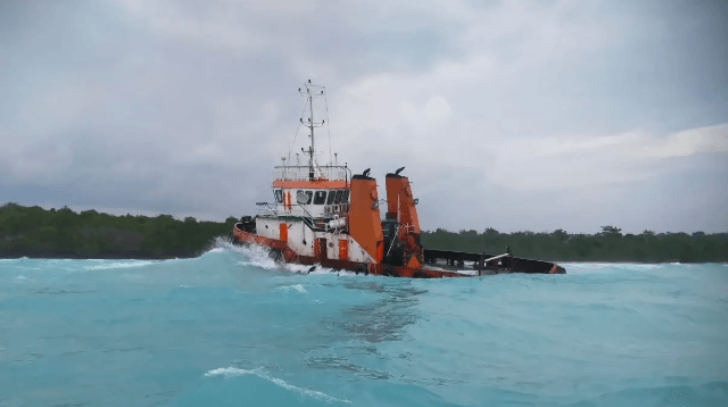Crew member Dies Trying to Reach Shore After Tug Grounding Off Sulawesi 印尼拖轮搁浅船员跳海求生!一船员不幸遇难
Crew member Dies Trying to Reach Shore After Tug Grounding Off Sulawesi
印尼拖轮搁浅船员跳海求生!一船员不幸遇难
One crewmember lost his life after a tug went aground at a remote beach in Southeast Sulawesi, according to rescue agency Basarnas.
据印度尼西亚国家搜救局(Basarnas)消息,一艘拖轮在东南苏拉威西省偏远海滩搁浅,事故导致一名船员不幸遇难。

图源网络
The incident occurred last Friday night (June 27, 2025). Amid severe weather and heavy seas, the tugboat was driven ashore and stranded near Tanjung Goram at the northern tip of Buton Island. The vessel was violently battered by massive waves and began taking on significant water, prompting the crew to initiate self-rescue actions. Around 22:30 that night, three crew members attempted to jump into the sea and swim ashore for help. One successfully reached the shore; another, overwhelmed by the rough seas, turned back and climbed back onto the tugboat; tragically, the third crew member perished during the attempt. His body was recovered the following morning.
The nearest SAR station was approximately 33 nautical miles from the incident site. Authorities only received the first report of the grounding around 02:00 on Saturday. A rescue team equipped with a Rigid Inflatable Boat (RIB) immediately set out, arriving at the scene around 05:40. Due to extremely adverse sea conditions, the rescue craft was initially unable to approach, leaving the rescuers unable to reach the six remaining crew members still trapped on the tugboat. It wasn't until around 08:30, as the waves gradually subsided, that all six crew members were safely evacuated ashore. All rescued crew were taken to a nearby medical center for examination. The identity of the deceased crew member has been confirmed, and his remains were transferred to a hospital morgue. The cause of the accident is under investigation.
事故发生于上周五(6月27日)夜间。一艘拖轮在恶劣天气和巨浪中,于布顿岛(Buton)北端的Tanjung Goram附近海域被冲上岸搁浅。船只遭到巨浪猛烈冲击,大量进水,船员随即展开自救行动。当晚约22时30分,三名船员试图跳入海中游泳上岸求援。其中一人成功抵达岸边;另一人因风浪太大中途放弃,折返并爬回了拖轮;而第三名船员在尝试过程中不幸遇难。其遗体于次日凌晨被寻获。
距离事发地点最近的搜救站约33海里。当局于周六凌晨约02时00分才首次接到搁浅事故报告。一支配备硬壳充气艇(RIB)的救援队随即出发,于约05时40分抵达现场。由于海面状况极其恶劣,救援艇无法靠近,救援人员最初无法接近仍被困在拖轮上的其余六名船员。直至约08时30分,海浪逐渐平息,六名船员才全部被安全转移至岸上。所有获救船员均被送往附近医疗中心进行检查。遇难船员身份已确认,其遗体已被送往医院停尸房,事故原因正在调查中。
The harsh climate near Tanjung Goram, Buton Island, where the tugboat incident occurred, is primarily influenced by a combination of its geographical location, topography, ocean currents, and the monsoon system.
Sulawesi Island is located near the equator (0°---5°South Latitude) and experiences alternating control by the Southeast Monsoon (Australian Monsoon) and the Northwest Monsoon. During the peak Southeast Monsoon period from May to September each year, strong southeast winds blow from the Australian high-pressure system towards the Asian low-pressure system. Passing over vast warm sea areas (such as the Banda Sea), these winds carry significant moisture, leading to heavy rainfall on Sulawesi's windward slopes.
The accident occurred during the Southeast Monsoon period, characterized by strong surface winds prone to generating huge waves and storm surges, which can cause vessels to lose control and run aground. The northern tip of Buton Island, Tanjung Goram, features a headland topography with open seas to the east and west. When southeast winds funnel through the narrow Buton Strait, they accelerate due to the "Venturi effect," concentrating wave height and intensifying sea conditions.
苏拉威西岛(特别是拖轮事故发生的布顿岛北端Tanjung Goram附近)气候恶劣主要受其地理位置、地形特征、海洋环流及季风系统的综合影响。
苏拉威西岛位于赤道附近(南纬0°—5°),受东南季风(澳洲季风) 和西北季风交替控制。每年5—9月东南季风鼎盛期,强劲东南风从澳大利亚高压吹向亚洲低压,途经广阔的温暖海域(如班达海),携带大量水汽,在苏拉威西岛迎风坡形成强降雨。
事故发生时正值东南季风期,海面风力强劲,易形成巨浪与风暴潮,导致船舶失控搁浅。布顿岛北端Tanjung Goram为岬角地形,东、西两侧海域开阔。当东南风通过狭窄的布顿海峡(Buton Strait) 时,受“狭管效应”挤压,风速加快,浪高集中,加剧海面风浪强度。
What Should Crew Do When a Ship Runs Aground?
船舶搁浅时,船员应该如何做?
Grounding incidents are relatively common among maritime accidents, mostly occurring in narrow channels/fairways/harbor areas with poor chart accuracy, or during heavy seas or poor visibility. After a grounding, the captain must remain calm, conduct a thorough survey to assess the situation, and take appropriate measures to mitigate the grounding and prevent further hull damage. Crucially, the captain should never attempt to refloat the vessel blindly using engine power, as reckless use of astern propulsion can worsen the situation, potentially leading to increased damage or even hull fracture.
The tragedy of crew members jumping overboard in this incident highlights the fatal risks of emergency decision-making errors under extreme sea conditions. According to the International Maritime Organization (IMO) International Convention for the Safety of Life at Sea (SOLAS) and professional maritime survival protocols, crew members should follow this scientific self-rescue procedure when a ship runs aground unexpectedly:
船舶搁浅事故在海损事故中发生的概率较高,大多数发生在测量精度不高的岛礁区狭水道/航道/港内等水域和大风浪或者能见度不良的情况下,船舶搁浅后,船长切忌惊慌失措,要冷静地进行调查和判断周围情况,采取适当措施来减轻搁浅程度,防止船体损伤扩大。同时,船长也千万不可盲目动车进行自力脱险,因为滥用主机倒车会使事态进一步恶化,甚至造成船舶破损扩大甚至断裂的危险。
此次事故中船员跳海求援的悲剧,凸显了极端海况下应急决策失误的风险。根据国际海事组织(IMO)《国际海上人命安全公约》(SOLAS)及专业海事求生规范,船舶意外搁浅时,船员应遵循以下科学自救流程:
❌ Jumping into heavy seas without life-saving equipment (the deceased crew member was not wearing any)
❌ Acting separately (three swimming dispersed their collective strength)
❌Overestimating swimming ability (the harsh environment and distance make exhaustion highly likely)
绝对禁忌:
❌ 无救生装备跳入巨浪(遇难船员未着救生装备)
❌ 分散行动(三人游泳导致力量瓦解)
❌ 高估游泳能力(环境恶劣且距离较远 极易体力不支)
(1) Immediate Action: Stabilize the Vessel and Personnel
Swiftly close all watertight doors, portholes, and vents to prevent further flooding.
Start the emergency generator to ensure power for critical equipment (communication, bilge pumps, lighting).
Measure water levels in all compartments, the vessel's angle of list, and seabed composition (mud/sand/rock).
Sound depths around the grounded hull to determine the extent of grounding. If heavy swells prevent accurate sounding, use a lead line to measure the distance from the main deck to the seabed as an indirect depth gauge.
If there is no risk of hull fracture, abandoning ship is strictly forbidden – the vessel is the highest-survival-rate refuge. If the vessel is relatively stable with no immediate danger, remain on board to await rescue, as a ship is a larger target more easily spotted by rescuers.
- 立即行动:稳定船舶与人员
火速关闭所有水密门、舷窗、通风口,阻止进水蔓延。启动应急发电机,保障关键设备(通讯、排水泵、照明)电力。
测量各舱室水位、船体倾斜角度、海底地质(泥沙/岩石)。对搁浅船船体周围进行测深,以便确定搁浅程度。若海面涌浪较大而无法准确测量时,可用铅锤测量主甲板至海底之间的距离间接获得水深。若船体无断裂风险,严禁弃船——船舶是最高生存率的避难所。如果船舶处于相对稳定状态且无立即的危险,尽量留在船上等待救援,因为船舶是一个较大的目标,更容易被救援人员发现。
(2) Precise Distress Call
Immediately use the vessel's communication equipment (e.g., VHF radio, satellite phone) to send a distress signal to nearby coast radio stations, SAR agencies, or other vessels. Report the vessel's position, nature of emergency, number of crew, and type of assistance required.
While awaiting rescue, all crew must don personal protective equipment (PPE) such as life jackets and helmets immediately. Ensure life jackets are securely fastened with reflective surfaces facing outwards to maximize visibility in the water.
The above outlines emergency measures to take after grounding. To prevent groundings, ship operators should proactively obtain vital information on local climate changes, weather forecasts, navigation channels and marks, and known shallow hazard areas. Navigate strictly according to regulations, exercise extreme caution, and eliminate negligence. Be vigilant for shoals and reefs, and implement robust precautions for severe weather. We sincerely hope all seafarers avoid groundings. Should an emergency arise, remain calm and employ appropriate self-rescue methods.
- 精准求救
立即使用船舶的通讯设备,如高频无线电、卫星电话等,向附近的海岸电台、搜救机构或其他船舶发出求救信号,报告船舶的位置、险情、船员人数以及所需的救援类型。在等待救援的过程中,船员应迅速穿戴好救生衣、头盔等个人防护装备。确保救生衣系紧且反光面朝外,以提高在水中的可见度。
以上为船舶搁浅后应采取的应急措施,为预防搁浅,船方应及时掌握当地气候变化、天气预报、航道和航标、浅点事故多发段等重要信息。在航行中要按规定航行,谨慎驾驶,杜绝工作中的疏忽大意。注意浅滩暗礁,做好恶劣天气预防措施。在此,希望广大船员远离搁浅,一旦遇到突发情况,要沉着冷静对待,采用适当的方法自救脱浅。








